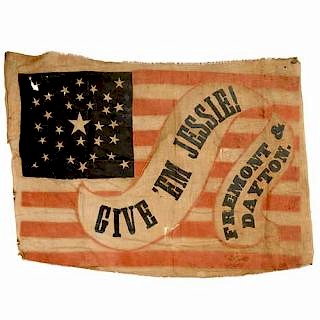Civil War Hand-Painted American Flag Made by POW, Charles Gilman, 6th Ohio Infantry
About Seller
6270 Este Ave.
Cincinnati , OH 45232
United States
With offices in Cincinnati, Cleveland and Denver, Cowan’s holds over 40 auctions each year, with annual sales exceeding $16M. We reach buyers around the globe, and take pride in our reputation for integrity, customer service and great results. A full-service house, Cowan’s Auctions specializes in Am...Read more
Two ways to bid:
- Leave a max absentee bid and the platform will bid on your behalf up to your maximum bid during the live auction.
- Bid live during the auction and your bids will be submitted real-time to the auctioneer.
Bid Increments
| Price | Bid Increment |
|---|---|
| $0 | $25 |
| $500 | $50 |
| $1,000 | $100 |
| $2,000 | $250 |
| $5,000 | $500 |
| $10,000 | $1,000 |
| $20,000 | $2,500 |
| $50,000 | $5,000 |
| $100,000 | $10,000 |
About Auction
Nov 18, 2016 - Nov 19, 2016
Cowan's Auctions dawnie@cowans.com
- Lot Description
Hand-painted American flag depicting 13 red stripes and 33 stars in the blue field, approx. 12 x 6.5 in., crudely and primitively executed on a very rough piece of canvas quite likely cut from a flour or meal bag by the prisoner-of-war whose name has been hand lettered in ink upon it at right, C. Gilman/ Prisoner of WAR/ Sep 19th 186[?] (last numeral partially destroyed by a wide tear). Although very aged in appearance, the reds and blues remain strong.
Accompanied by vast amount of detailed information regarding Charles Gilman, who served as first lieutenant and later captain with Company A, 6th Ohio Regiment of Infantry. Records indicate he was captured by the Confederates on September 11, 1861 “…while on picket [duty]." On August 31, 1862, his record shows that he continued to be “in hands of enemy since September 11, 1861." The record does not reveal how he was released, but it does show that by September 1862, Gilman was back with his original Company C of the 6th Ohio Infantry and promoted to first lieutenant at the time. By early April 1863, Gilman had accepted a promotion to captain in that same 6th Ohio Infantry. Records of September and October of 1863 reflect his having been wounded at the Battle of Chickamauga on September 19, 1863. The wounds he received in action resulted in his disability and discharge from service.
Others from the outfit referenced above mention that Gilman was taken “…prisoner by the enemy while on duty near Camp Elkwater, Virginia on September 11, 1861” and that he was also a prisoner of war in Richmond until August, 1862. The same records (on the very same page) also mention “taken prisoner by the enemy at Stewarts Run, Virginia September 11, 1861" (research indicates that Stewarts Run is in the same general area as Camp Elkwater). The date of September 19th that is noted on the flag is coincidental, for in a record document titled “MEMORANDUM FROM PRISONER OF WAR RECORDS” (amongst the service records received from the archives), it specifically shows that Gilman was "confined at Richmond, Virginia September 19, 1861." However, the same document shows Gilman being “Captured at Cheat Mt September 11, 1861." Nevertheless, this clearly indicates that the date inscribed upon the flag represents the day that he first arrived at the Richmond prison. The document also shows that Gilman was later “sent to Tuscaloosa November 25, 1861.”
Although the flag is a seemingly crude relic, it exudes a tremendous air and feeling of pathos and suffering undergone by the fellow that made it during a time of terrible strife and grief, and yet bespeaks his patriotism and undoubtedly the feeling of that love for his country that this simple relic strongly suggests.
Provenance: Property of N. Flayderman & Co.Inked inscription, last number in date 186? partially destroyed by a wide tear. Wear and soiling to flag, but colors remain strong. Hole in "G" in "Gilman," possibly result of inked inscription.Condition
- Shipping Info
-
SHIPPING. At the request of the buyer, Cowan's will authorize the shipment of purchased items. Shipments usually occur within two weeks after payment has been received. Shipment is generally made via UPS Ground service. Unless buyer gives special instructions, the shipping method shall be at the sole discretion of Cowan's Auctions, Inc.. Cowan's is in no way responsible for the acts or omissions of independent handlers, packers or shippers of purchased items or for any loss, damage or delay from the packing or shipping of any property.
-
- Buyer's Premium



 EUR
EUR CAD
CAD AUD
AUD GBP
GBP MXN
MXN HKD
HKD CNY
CNY MYR
MYR SEK
SEK SGD
SGD CHF
CHF THB
THB












